Fabrication of Novel CeO2/GO/CNTs Ternary Nanocomposites with Enhanced Tribological Performance
Abstract
:1. Introduction
2. Experimental
2.1. Materials
2.2. Preparation of CeO2/GO/CNTs Nanocomposites
2.3. Characterization
2.4. Analysis of Tribological Performance
3. Results and Discussion
4. Conclusions
Author Contributions
Funding
Conflicts of Interest
References
- Min, C.; Liu, D. Preparation of novel polyimide nanocomposites with high mechanical and tribological performance using covalent modified carbon nanotubes via Friedel-Crafts reaction. Polymer 2018, 150, 223–231. [Google Scholar] [CrossRef]
- Wang, J.; Zhang, J.H. Study on Lubrication Performance of Journal Bearing with Multiple Texture Distributions. Appl. Sci. 2018, 8, 244. [Google Scholar] [CrossRef]
- Wang, J.; Cai, M. Experimental Evaluation of Lubrication Characteristics of a New Type Oil-Film Bearing Oil Using Multi-Sensor System. Appl. Sci. 2017, 7, 28. [Google Scholar] [CrossRef]
- Lee, K.; Hwang, Y.; Cheong, S. Understanding the role of nanoparticles in nano-oil lubrication. Tribol. Lett. 2009, 35, 127–131. [Google Scholar] [CrossRef]
- Shahnazar, S.; Bagheri, S.; Hamid, S.B.A. Enhancing lubricant properties by nanoparticle additives. Int. J. Hydrogen Energy 2016, 41, 3153–3170. [Google Scholar] [CrossRef]
- Bakunin, V.N.; Suslov, A.Y.; Kuzmina, G.N. Synthesis and application of inorganic nanoparticles as lubricant components—A review. J. Nanopart. Res. 2004, 6, 273–284. [Google Scholar] [CrossRef]
- Li, B.; Wang, X.; Liu, W. Tribochemistry and antiwear mechanism of organic-inorganic nanoparticles as lubricant additives. Tribol. Lett. 2006, 22, 79–84. [Google Scholar] [CrossRef]
- Min, C.; Liu, D.; Shen, C. Remarkable improvement of the wear resistance of poly(vinylidene difluoride) by incorporating polyimide powder and carbon nanofibers. Appl. Phys. A Mater. Sci. Process. 2017, 123, 638. [Google Scholar] [CrossRef]
- Min, C.; Liu, D.; Shen, C. Unique synergistic effects of graphene oxide and carbon nanotube hybrids on the tribological properties of polyimide nanocomposites. Tribol. Int. 2018, 117, 217–224. [Google Scholar] [CrossRef]
- Xue, M.; Wang, Z.; Yuan, F. Preparation of TiO2/Ti3C2Tx hybrid nanocomposites and their tribological properties as base oil lubricant additives. RSC Adv. 2017, 7, 4312–4319. [Google Scholar] [CrossRef]
- Xu, D.; Tong, Y.; Yan, T.T.; Shi, L.Y.; Zhang, D.S. N,P-Codoped Meso-/Microporous Carbon Derived from Biomass Materials via a Dual-Activation Strategy as High-Performance Electrodes for Deionization Capacitors. ACS Sustain. Chem. Eng. 2017, 5, 5810–5819. [Google Scholar] [CrossRef]
- Li, W.; Cheng, Z.L.; Liu, Z. Novel Preparation of Calcium Borate/Graphene Oxide Nanocomposites and Their Tribological Properties in Oil. J. Mater. Eng. Perform. 2017, 26, 285–291. [Google Scholar] [CrossRef]
- Wang, Z.; Ren, R.; Song, H. Improved tribological properties of the synthesized copper/carbon nanotube nanocomposites for rapeseed oil-based additives. Appl. Surf. Sci. 2018, 428, 630–639. [Google Scholar] [CrossRef]
- Zhuoming, G.U.; Caixiang, G.U.; Shaoqing, F. Study on Lubricating Oils Containing Mixtures Additives of Nano-CaCO and Nano-Cu. J. Mater. Eng. 2007, 21, 19–22. [Google Scholar] [CrossRef]
- Cadek, M.; Coleman, J.N.; Ryan, K.P. Reinforcement of polymers with carbon nanotubes: The role of nanotube surface area. Nano Lett. 2004, 4, 353–356. [Google Scholar] [CrossRef]
- George, R.; Kashyap, K.T.; Rahul, R. Strengthening in carbon nanotube/aluminium (CNT/Al) composites. Scr. Mater. 2005, 53, 1159–1163. [Google Scholar] [CrossRef]
- Curtin, W.A.; Sheldon, B.W. CNT-reinforced ceramics and metals. Mater. Today 2004, 7, 44–49. [Google Scholar] [CrossRef]
- Gofman, I.; Zhang, B.; Zang, W. Specific features of creep and tribological behavior of polyimide-carbon nanotubes nanocomposite films: Effect of the nanotubes functionalization. J. Polym. Res. 2013, 20, 258. [Google Scholar] [CrossRef]
- Chen, C.S.; Chen, X.H.; Xu, L.S. Modification of multi-walled carbon nanotubes with fatty acid and their tribological properties as lubricant additive. Carbon 2005, 43, 1660–1666. [Google Scholar] [CrossRef]
- Ji, L.; Rao, M.; Zheng, H. Graphene oxide as a sulfur immobilizer in high performance lithium/sulfur cells. J. Am. Chem. Soc. 2017, 133, 18522–18525. [Google Scholar] [CrossRef]
- Chen, D.; Feng, H.; Li, J. Graphene Oxide: Preparation, Functionalization, and Electrochemical Applications. Chem. Rev. 2012, 112, 6027–6053. [Google Scholar] [CrossRef] [PubMed]
- Paredes, J.I.; Villar-Rodil, S.; Martinez-Alonso, A. Graphene Oxide Dispersions in Organic Solvents. Langmuir 2008, 24, 10560–10564. [Google Scholar] [CrossRef] [PubMed]
- Kim, H.J.; Penkov, O.V.; Kim, D.E. Tribological Properties of Graphene Oxide Nanosheet Coating Fabricated by Using Electrodynamic Spraying Process. Tribol. Lett. 2015, 57, 27. [Google Scholar] [CrossRef]
- Yang, J.; Xia, Y.; Song, H.; Chen, B.; Zhang, Z. Synthesis of the liquid-like graphene with excellent tribological properties. Tribol. Int. 2017, 105, 118–124. [Google Scholar] [CrossRef]
- Zhang, S.; Yang, J.; Chen, B.; Guo, S.; Li, J.; Li, C. One-step hydrothermal synthesis of reduced graphene oxide/zinc sulfide hybrids for enhanced tribological properties of epoxy coatings. Surf. Coat. Technol. 2017, 326, 87–95. [Google Scholar] [CrossRef]
- Chen, B.; Li, X.; Jia, Y.; Xu, L.; Liang, H.Y. Fabrication of ternary hybrid of carbon nanotubes/graphene oxide/MoS2 and its enhancement on the tribological properties of epoxy composite coatings. Compos. Part A 2018, 115, 157–165. [Google Scholar] [CrossRef]
- Xin, Y.; Li, T.; Gong, D. Preparation and tribological properties of graphene oxide/nano-MoS2 hybrid as multidimensional assembly used in the polyimide nanocomposites. RSC Adv. 2017, 7, 6323–6335. [Google Scholar] [CrossRef]
- Zhang, X.; Luster, B.; Church, A.; Muratore, C.; Voevodin, A.A.; Kohli, P. Carbon nanotube-MoS2 composites as solid lubricants. ACS Appl. Mater. Interfaces 2009, 1, 735–739. [Google Scholar] [CrossRef]
- Bai, G.Y.; Wang, J.Q.; Yang, Z.G.; Wang, H.G. Preparation of a highly effective lubricating oil additive—Ceria/graphene composite. RSC Adv. 2014, 4, 47096–47105. [Google Scholar] [CrossRef]
- Cote, L.J.; Kim, J.; Tung, V.C.; Luo, J. Graphene oxide as surfactant sheets. Pure Appl. Chem. 2011, 83, 95–110. [Google Scholar] [CrossRef]
- Kim, J.; Cote, L.J.; Kim, F.; Yuan, W. Graphene Oxide Sheets at Interfaces. J. Am. Chem. Soc. 2010, 132, 8180–8186. [Google Scholar] [CrossRef]
- Marcano, D.C.; Kosynkin, D.V.; Berlin, J.M. Improved Synthesis of Graphene Oxide. ACS Nano 2010, 4, 4806–4814. [Google Scholar] [CrossRef] [Green Version]
- Zhou, Y.Z.; Yang, J.; Cheng, X.N. Electrostatic self-Assembly of graphene-silver multilayer films and their transmittance and electronic conductivity. Carbon 2012, 50, 4343–4350. [Google Scholar] [CrossRef]
- Yang, S.Y.; Lin, W.N.; Huang, Y.L. Synergetic effects of graphene platelets and carbon nanotubes on the mechanical and thermal properties of epoxy composites. Carbon 2011, 49, 793–803. [Google Scholar] [CrossRef]
- Xu, H.F.; Li, H. The effect of CO-doped on the room-temperature ferromagnetism of CeO2 nanorods. J. Magn. Magn. Mater. 2015, 377, 272–275. [Google Scholar] [CrossRef]
- Ammar, M.R.; Galy, N.; Rouzaud, J.N. Characterizing various types of defects in nuclear graphite using Raman scattering: Heat treatment, ion irradiation and polishing. Carbon 2015, 95, 364–373. [Google Scholar] [CrossRef]
- Pham, D.T.; Lee, T.H.; Luong, D.H. Carbon nanotube-bridged graphene 3D building blocks for ultrafast compact supercapacitors. ACS Nano 2015, 9, 2018–2027. [Google Scholar] [CrossRef]
- Yamamoto, G.; Hashida, T.; Adachi, K.; Takagi, T. Tribological Properties of Single-Walled Carbon Nanotube Solids. J. Nanosci. Nanotechnol. 2008, 8, 665–2670. [Google Scholar] [CrossRef]
- Zhang, J.; Chen, C.; Yan, W. Ni nanoparticles supported on CNTs with excellent activity produced by atomic layer deposition for hydrogen generation from hydrolysis of ammonia borane. Catal. Sci. Technol. 2016, 6, 2112–2119. [Google Scholar] [CrossRef]
- Yousef, S.; Visco, A.; Galtieri, G. Wear behaviour of UHMWPE reinforced by carbon nanofiller and paraffin oil for joint replacement. Mater. Sci. Eng. C 2017, 73, 234–244. [Google Scholar] [CrossRef]
- Song, H.; Wang, Z.; Yang, J. Tribological properties of graphene oxide and carbon spheres as lubricating additives. Appl. Phys. A 2016, 122, 933. [Google Scholar] [CrossRef]
- Bai, G.Y.; Wang, J.Q.; Yang, Z.G. Self-assembly of ceria/graphene oxide composite films with ultra-long antiwear lifetime under a high applied load. Carbon 2015, 84, 197–206. [Google Scholar] [CrossRef]
- Song, H.J.; Wang, Z.Q.; Yang, J.; Jia, X.H. Facile synthesis of copper/polydopamine functionalized graphene oxide nanocomposites with enhanced tribological performance. Chem. Eng. J. 2017, 324, 51–62. [Google Scholar] [CrossRef]


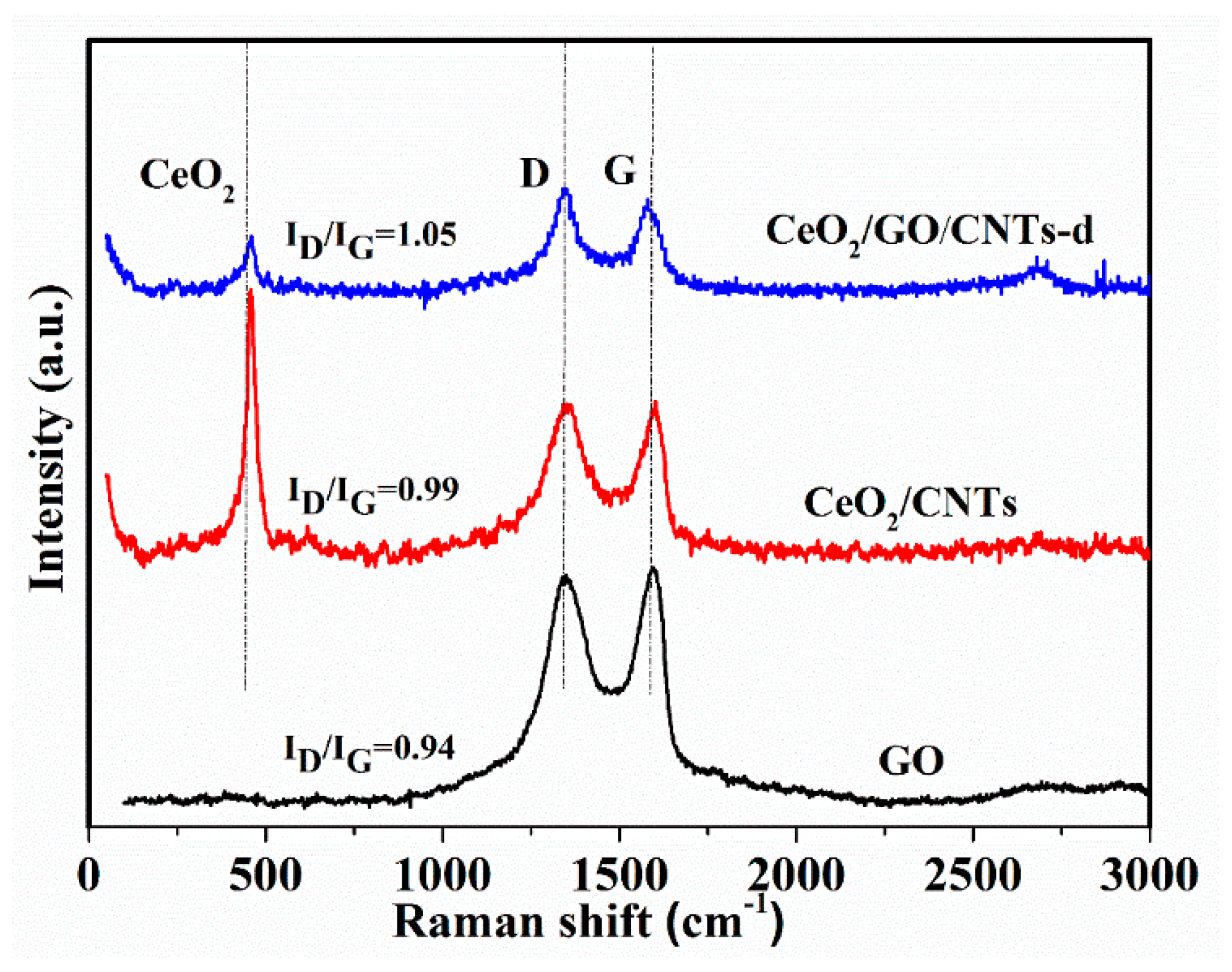
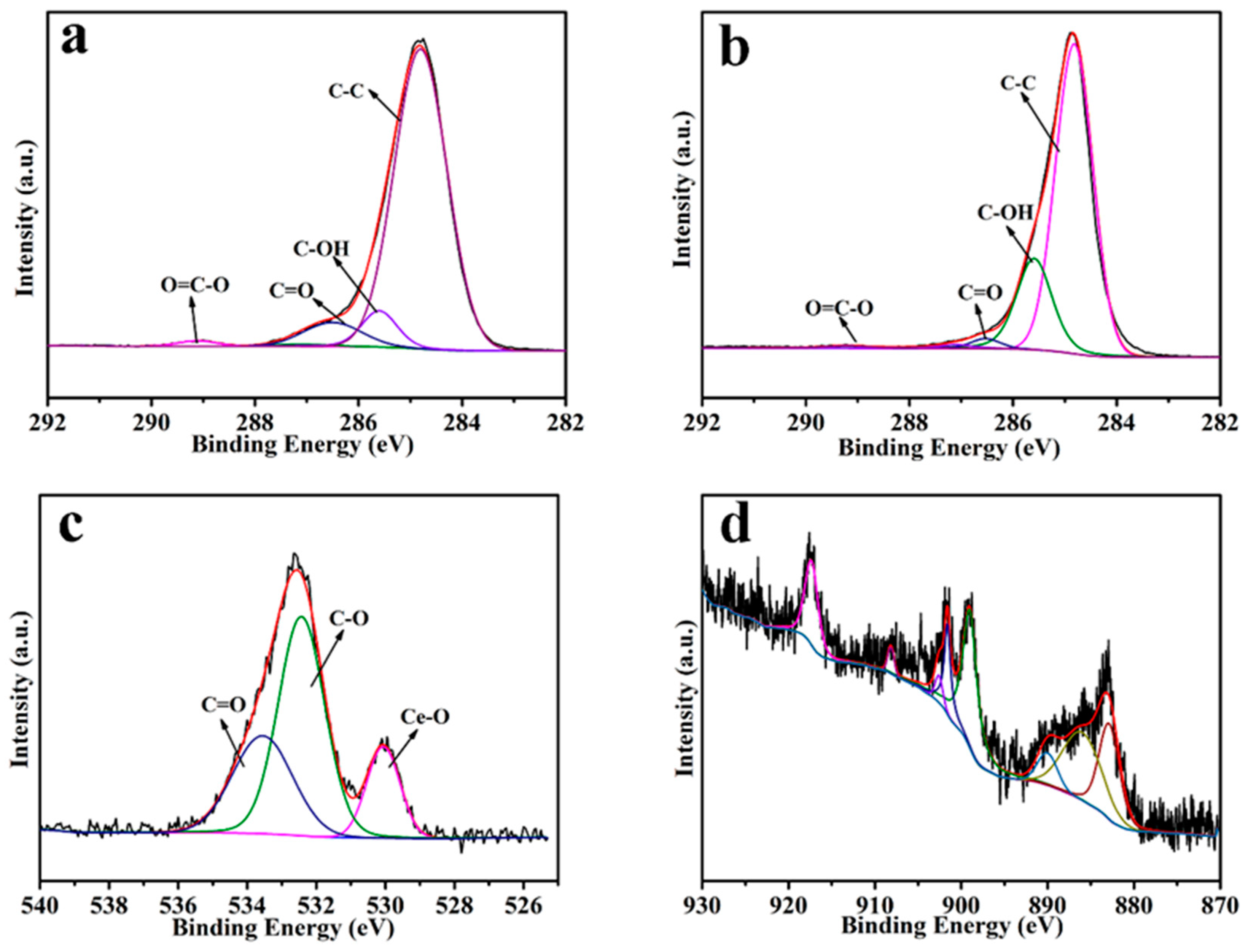

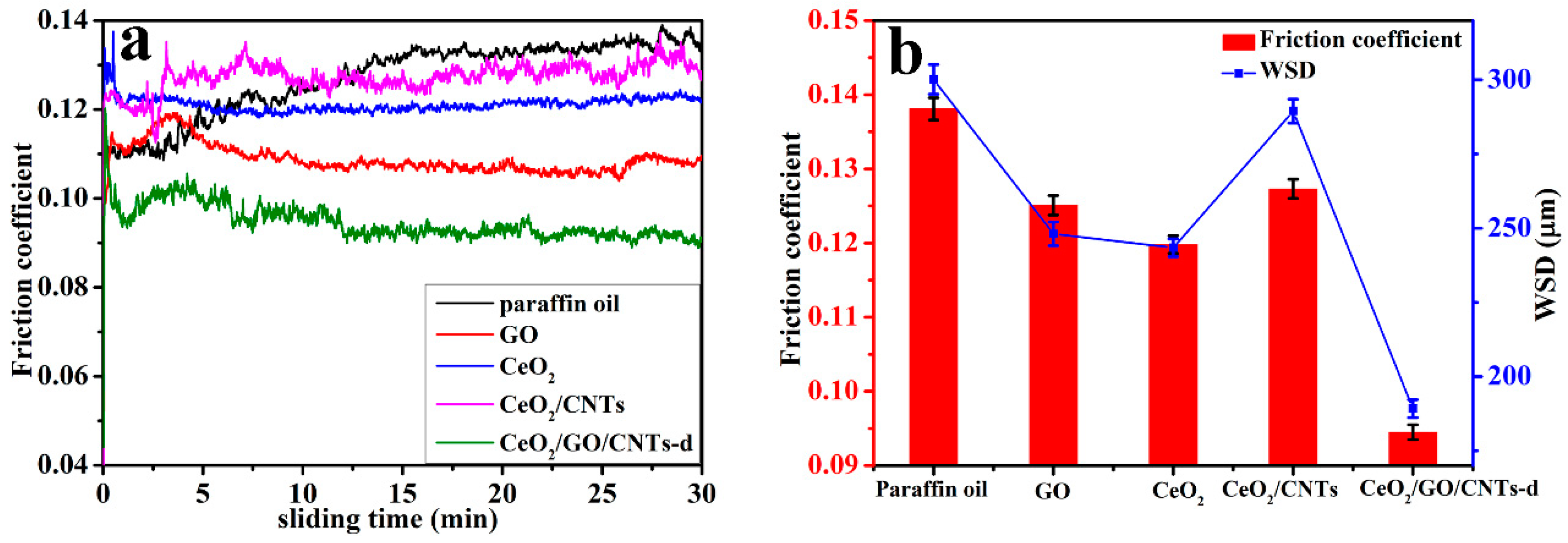
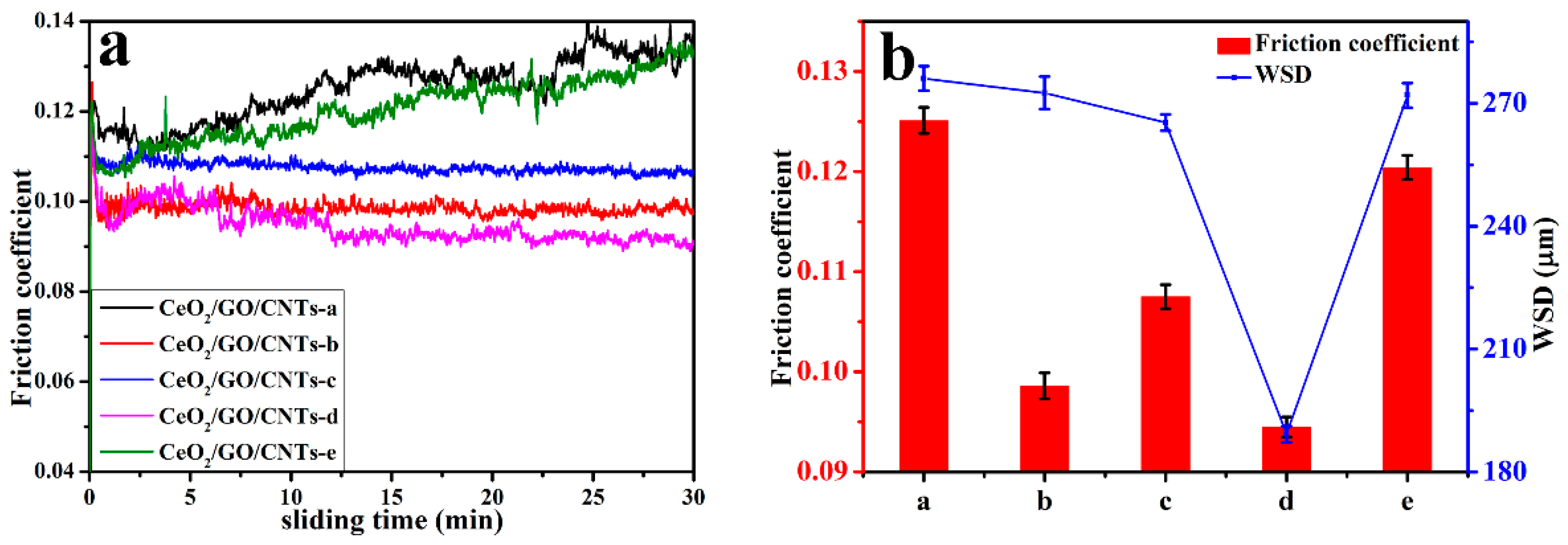
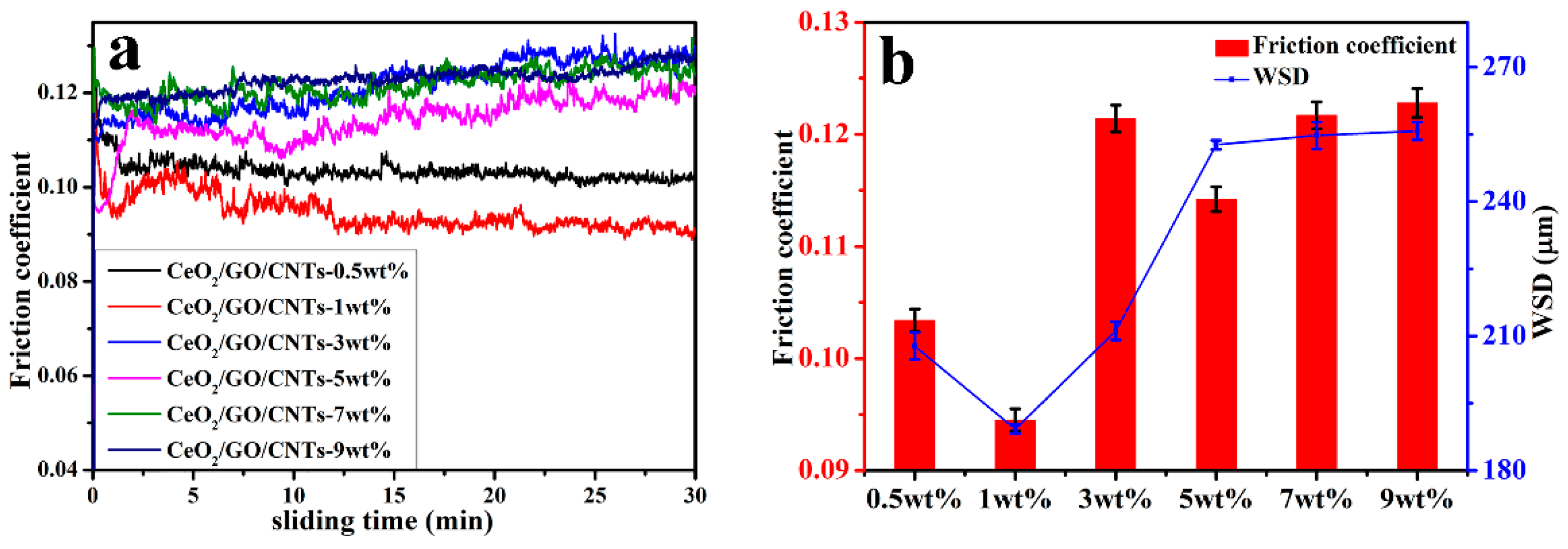
© 2019 by the authors. Licensee MDPI, Basel, Switzerland. This article is an open access article distributed under the terms and conditions of the Creative Commons Attribution (CC BY) license (http://creativecommons.org/licenses/by/4.0/).
Share and Cite
Min, C.; He, Z.; Song, H.; Liu, D.; Jia, W.; Qian, J.; Jin, Y.; Guo, L. Fabrication of Novel CeO2/GO/CNTs Ternary Nanocomposites with Enhanced Tribological Performance. Appl. Sci. 2019, 9, 170. https://doi.org/10.3390/app9010170
Min C, He Z, Song H, Liu D, Jia W, Qian J, Jin Y, Guo L. Fabrication of Novel CeO2/GO/CNTs Ternary Nanocomposites with Enhanced Tribological Performance. Applied Sciences. 2019; 9(1):170. https://doi.org/10.3390/app9010170
Chicago/Turabian StyleMin, Chunying, Zengbao He, Haojie Song, Dengdeng Liu, Wei Jia, Jiamin Qian, Yuhui Jin, and Li Guo. 2019. "Fabrication of Novel CeO2/GO/CNTs Ternary Nanocomposites with Enhanced Tribological Performance" Applied Sciences 9, no. 1: 170. https://doi.org/10.3390/app9010170



